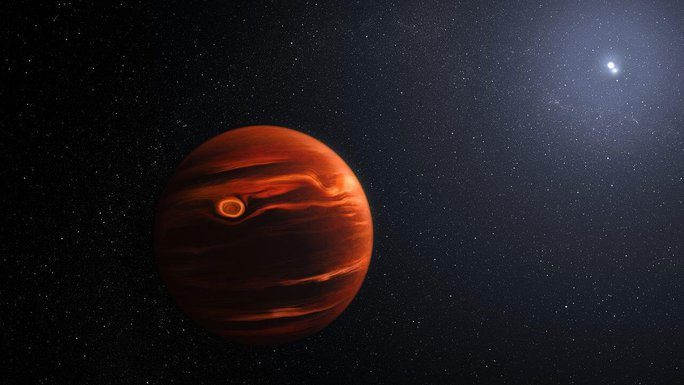A massive planet that defies the boundary separating planets from brown dwarfs has just been discovered between two other “suns,” exhibiting Earth-like phenomena but in a much more catastrophic form.
The “monster” world named WHS 1256 b is indeed a planet, as it has not one but two parent stars; however, it far exceeds the mass limit for a planet, which is typically 10-13 times that of Jupiter.
According to Science Alert, this peculiar planet weighs about 20 times that of Jupiter, equivalent to 6,360 times Earth, and has temperatures so high that aluminum would melt. It also has an orbit that takes 10,000 years around its two parent stars.

WHS 1256 b is extraordinary, surpassing the theoretical astronomical boundaries and has been observed in detail by the James Webb Space Telescope – (Image: NASA/ESA/CSA)
It was discovered in a state surrounded by sandstorms using NASA/ESA/CSA’s James Webb Space Telescope, but unlike Earth’s sandstorms, these are extreme, never-ending tempests.
The catastrophic sandstorms have caused swirling clouds filled with silicate particles to circulate throughout the planet’s atmosphere.
According to astrophysicist Paul Molliere from the Max Planck Institute for Astronomy (Germany), this is the first time so much information has been revealed through a single spectral data set. This is all thanks to the James Webb, which possesses capabilities far superior to its predecessors.
This is also the first time a world exceeding the mass limit for planets has been confirmed to be a planet, rather than a brown dwarf—an object that can be considered a failed star or a high-end planet, too small to initiate stellar nuclear fusion but too large to be classified as a planet, and without a parent star.
One possibility suggested is that this mysterious object was born through a “hybrid” formation process between brown dwarfs and planets.
Brown dwarfs do not have parent stars and form from the direct collapse of a gas and dust cloud between stars, but they fail to ignite and thus are not truly stars. In contrast, planets form from the gas and dust disks of stars.
Since WHS 1256 b has two parent stars, it is likely formed from a combined gas and dust cloud of those stars, with a similar collapse mechanism to that of a brown dwarf.
This planet is quite young, only 150 million years old, and is still extremely hot, with its atmosphere reaching temperatures around 830 degrees Celsius, combined with low gravity that creates a chaotic sky.
With an orbit that takes 10,000 Earth years, this planet is far enough away that its light does not mix with that of its stars, creating excellent conditions for scientists to test exoplanet observation methods.
The research was recently published in The Astrophysical Journal Letters.


















































